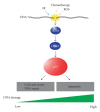Roles of p53 in various biological aspects of hematopoietic stem cells
- PMID: 22778557
- PMCID: PMC3388322
- DOI: 10.1155/2012/903435
Roles of p53 in various biological aspects of hematopoietic stem cells
Abstract
Hematopoietic stem cells (HSCs) have the capacity to self-renew as well as to differentiate into all blood cell types, and they can reconstitute hematopoiesis in recipients with bone marrow ablation. In addition, transplantation therapy using HSCs is widely performed for the treatment of various incurable diseases such as hematopoietic malignancies and congenital immunodeficiency disorders. For the safe and successful transplantation of HSCs, their genetic and epigenetic integrities need to be maintained properly. Therefore, understanding the molecular mechanisms that respond to various cellular stresses in HSCs is important. The tumor suppressor protein, p53, has been shown to play critical roles in maintenance of "cell integrity" under stress conditions by controlling its target genes that regulate cell cycle arrest, apoptosis, senescence, DNA repair, or changes in metabolism. In this paper, we summarize recent reports that describe various biological functions of HSCs and discuss the roles of p53 associated with them.
Figures




Similar articles
-
The p53 tumor suppressor protein is a critical regulator of hematopoietic stem cell behavior.Cell Cycle. 2009 Oct 1;8(19):3120-4. doi: 10.4161/cc.8.19.9627. Cell Cycle. 2009. PMID: 19755852 Free PMC article. Review.
-
The p53 tumor suppressor protein regulates hematopoietic stem cell fate.J Cell Physiol. 2011 Sep;226(9):2215-21. doi: 10.1002/jcp.22561. J Cell Physiol. 2011. PMID: 21660944 Free PMC article. Review.
-
[Maintenance of hematopoietic stem cell integrity and regulation of leukemogenesis by p53 and its coactivator Aspp1].Rinsho Ketsueki. 2015 Dec;56(12):2426-33. doi: 10.11406/rinketsu.56.2426. Rinsho Ketsueki. 2015. PMID: 26725350 Review. Japanese.
-
Aspp1 Preserves Hematopoietic Stem Cell Pool Integrity and Prevents Malignant Transformation.Cell Stem Cell. 2015 Jul 2;17(1):23-34. doi: 10.1016/j.stem.2015.05.013. Epub 2015 Jun 25. Cell Stem Cell. 2015. PMID: 26119234
-
Hematopoietic insults damage bone marrow niche by activating p53 in vascular endothelial cells.Exp Hematol. 2018 Jul;63:41-51.e1. doi: 10.1016/j.exphem.2018.04.006. Epub 2018 Apr 27. Exp Hematol. 2018. PMID: 29709619
Cited by
-
Enhancing Hematopoietic Stem Cell Transplantation Efficacy by Mitigating Oxygen Shock.Cell. 2015 Jun 18;161(7):1553-65. doi: 10.1016/j.cell.2015.04.054. Epub 2015 Jun 11. Cell. 2015. PMID: 26073944 Free PMC article.
-
PLAG1 dampens protein synthesis to promote human hematopoietic stem cell self-renewal.Blood. 2022 Sep 1;140(9):992-1008. doi: 10.1182/blood.2021014698. Blood. 2022. PMID: 35639948 Free PMC article.
-
The orally bioavailable MDM2 antagonist RG7112 and pegylated interferon α 2a target JAK2V617F-positive progenitor and stem cells.Blood. 2014 Jul 31;124(5):771-9. doi: 10.1182/blood-2013-11-536854. Epub 2014 May 28. Blood. 2014. PMID: 24869939 Free PMC article. Clinical Trial.
-
miR-125a is upregulated in cancer stem-like cells derived from TW01 and is responsible for maintaining stemness by inhibiting p53.Oncol Lett. 2019 Jan;17(1):87-94. doi: 10.3892/ol.2018.9587. Epub 2018 Oct 16. Oncol Lett. 2019. PMID: 30655742 Free PMC article.
-
p53-TP53-Induced Glycolysis Regulator Mediated Glycolytic Suppression Attenuates DNA Damage and Genomic Instability in Fanconi Anemia Hematopoietic Stem Cells.Stem Cells. 2019 Jul;37(7):937-947. doi: 10.1002/stem.3015. Epub 2019 May 3. Stem Cells. 2019. PMID: 30977208 Free PMC article.
References
-
- Gussoni E, Soneoka Y, Strickland CD, et al. Dystrophin expression in the mdx mouse restored by stem cell transplantation. Nature. 1999;401(6751):390–394. - PubMed
-
- Arai F, Hirao A, Ohmura M, et al. Tie2/angiopoietin-1 signaling regulates hematopoietic stem cell quiescence in the bone marrow niche. Cell. 2004;118(2):149–161. - PubMed
-
- Akala OO, Park IK, Qian D, Pihalja M, Becker MW, Clarke MF. Long-term haematopoietic reconstitution by Trp53−/−p16Ink4a-/-p19Arf-/- multipotent progenitors. Nature. 2008;453(7192):228–232. - PubMed
Publication types
MeSH terms
Substances
LinkOut - more resources
Full Text Sources
Medical
Research Materials
Miscellaneous

